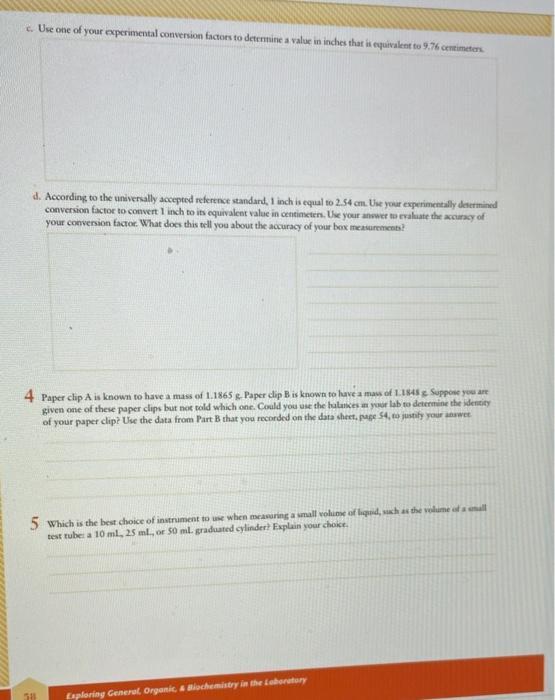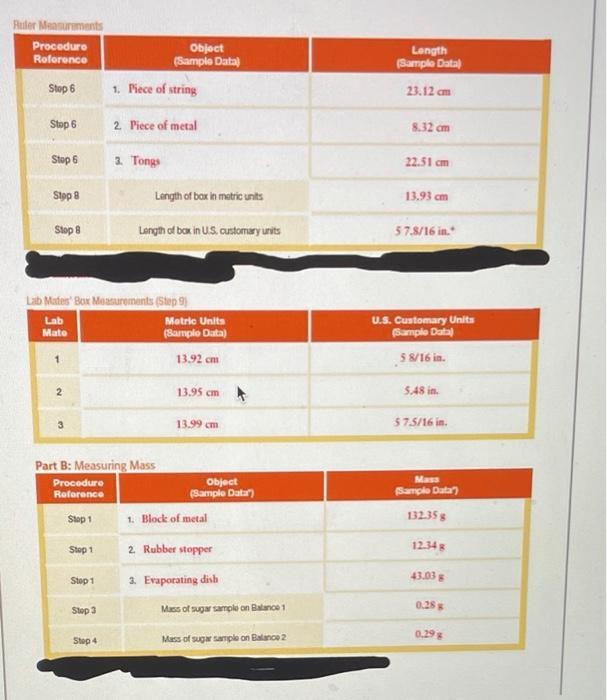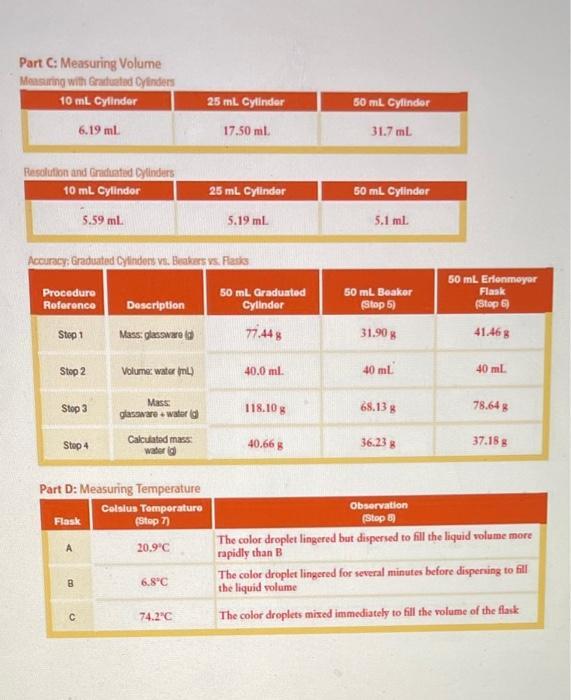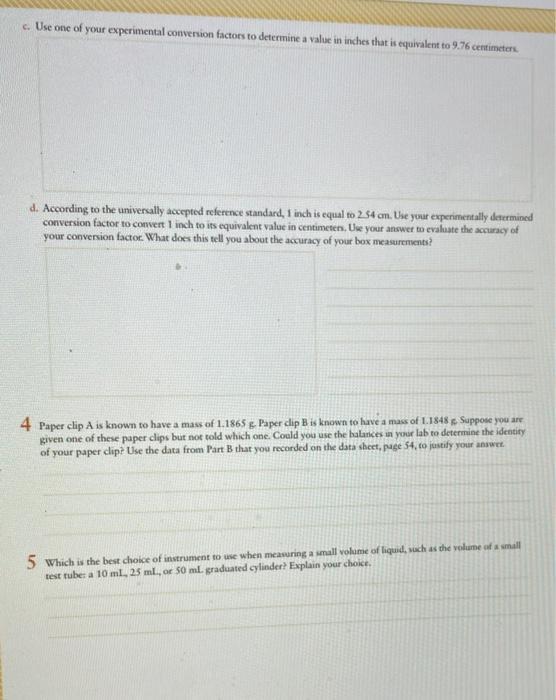Answered step by step
Verified Expert Solution
Question
1 Approved Answer
c. Use one of your experimental conversion factors to determine a value in inches that is equivalent to 9.76 centimeters d. According to the





c. Use one of your experimental conversion factors to determine a value in inches that is equivalent to 9.76 centimeters d. According to the universally accepted reference standard, 1 inch is equal to 2.54 cm. Use your experimentally determined conversion factor to convert 1 inch to its equivalent value in centimeters. Use your answer to evaluate the accuracy of your conversion factor. What does this tell you about the accuracy of your box measurements? 4 Paper clip A is known to have a mass of 1.1865 g. Paper clip B is known to have a mass of 1.1848 g. Suppose you are given one of these paper clips but not told which one. Could you use the balances in your lab to determine the identity of your paper clip? Use the data from Part B that you recorded on the data sheet, page 54, to justify your answer 5 Which is the best choice of instrument to use when measuring a small volume of liquid, such as the volume of a chall test tube: a 10 ml, 25 ml., or 50 ml. graduated cylinder? Explain your choice. 58 Exploring General Organic & Biochemistry in the Laboratory DATA SHEET 2.2 Part A: Measuring Length Ruler Observations Procedure Reference Step 2 Step 3 Step 4 Step 5 Description Units associated with numbered markings on Si scale Value of smallest lines on the Sl scale Units associated with numbered markings on the U.S. customary scale Values of smallest lines on the U.S. customary scale Observation cm 0.1 cm (1 mm) in. 1/16 in. (0.0625 in) Ruler Measurements Procedure Reference Stop 6 Stop 6 Stop 6 Stop 8 Stop 8 1 2 3 Stop 1 Lab Mates' Box Measurements (Step 9) Lab Mato Step 1 Stop 3 1. Piece of string Step 4 Object (Sample Data) 2. Piece of metal 3. Tongs Part B: Measuring Mass Procedure Reference Stop 1 Length of box in metric units Length of box in U.S. customary units Matric Units (Samplo Data) 13.92 cm 13.95 cm 13.99 cm Object (Sample Data") 1. Block of metal 2. Rubber stopper 3. Evaporating dish Mass of sugar sample on Balance 1 Mass of sugar sample on Balance 2 Length (Sample Data) 23.12 cm 8.32 cm 22.51 cm 13.93 cm 57.8/16 in.* U.S. Customary Units (Sample Data) 58/16 in. 5.48 in. $7.5/16 in. Mass (Sample Data) 132.35 g 12.34 g 43.03 g 0.28 g 0.29 g Part C: Measuring Volume Measuring with Graduated Cylinders 10 mL Cylinder 6.19 ml. Resolution and Graduated Cylinders 10 mL Cylindor Procedure Reference Step 1 5.59 ml. Accuracy: Graduated Cylinders vs. Beakers vs. Flasks Stop 2 Stop 3 Stop 4 Flask A B C Description Mass: glassware (d) Part D: Measuring Temperature Colsius Temperaturo (Stop 7) 20.9C Volume: water (ml) Mass: glassware+water (d Calculated mass water (d 6.8C 25 mL Cylinder 17.50 ml. 74.2C 25 mL Cylinder 5.19 ml 50 mL Graduated Cylinder 77.448 40.0 ml. 118.10 g 40.66 g 50 mL Cylinder 31.7 ml 50 mL Cylinder 5.1 ml. 50 mL Beaker (Stop 5) 31.90 g 40 ml 68.13 g 36.23 g Observation (Stop 8) 50 mL Erfonmoyor Flask (Stop 6) 41.46 g 40 ml. 78.64 g 37.18 g The color droplet lingered but dispersed to fill the liquid volume more rapidly than B The color droplet lingered for several minutes before dispersing to fill the liquid volume The color droplets mixed immediately to fill the volume of the flask c. Use one of your experimental conversion factors to determine a value in inches that is equivalent to 9.76 centimeters. d. According to the universally accepted reference standard, 1 inch is equal to 2.54 cm. Use your experimentally determined conversion factor to convert 1 inch to its equivalent value in centimeters. Use your answer to evaluate the accuracy of your conversion factor. What does this tell you about the accuracy of your box measurements? 4 Paper clip A is known to have a mass of 1.1865 g. Paper clip B is known to have a mass of 1.1848 g. Suppose you are given one of these paper clips but not told which one. Could you use the balances in your lab to determine the identity of your paper clip? Use the data from Part B that you recorded on the data sheet, page 54, to justify your answer. 5 Which is the best choice of instrument to use when measuring a small volume of liquid, such as the volume of a small test tube: a 10 ml, 25 ml., or 50 ml. graduated cylinder? Explain your choice.
Step by Step Solution
★★★★★
3.37 Rating (166 Votes )
There are 3 Steps involved in it
Step: 1
Conversion factor for d cm to inches 976 inch ...
Get Instant Access to Expert-Tailored Solutions
See step-by-step solutions with expert insights and AI powered tools for academic success
Step: 2

Step: 3

Ace Your Homework with AI
Get the answers you need in no time with our AI-driven, step-by-step assistance
Get Started


